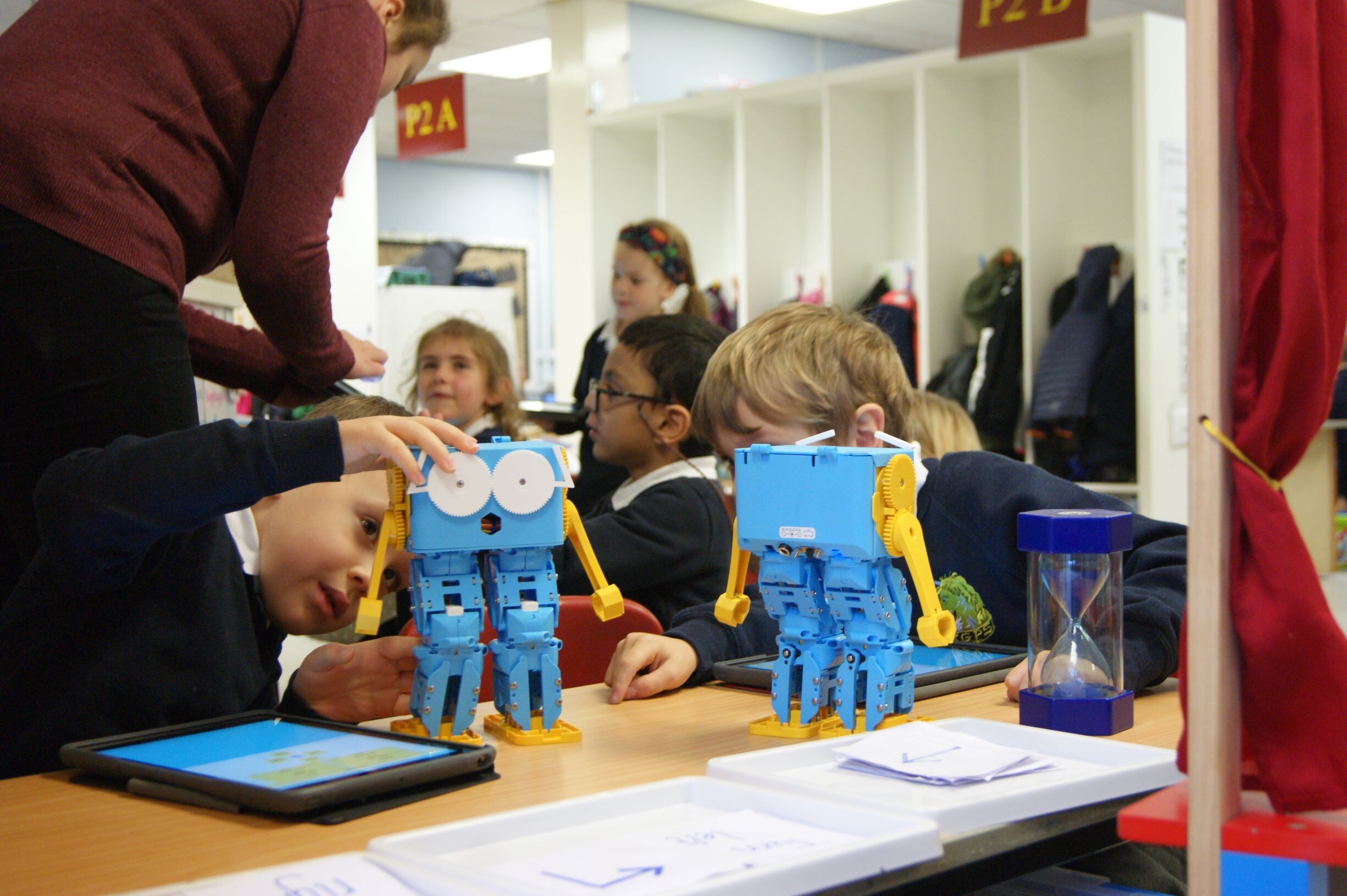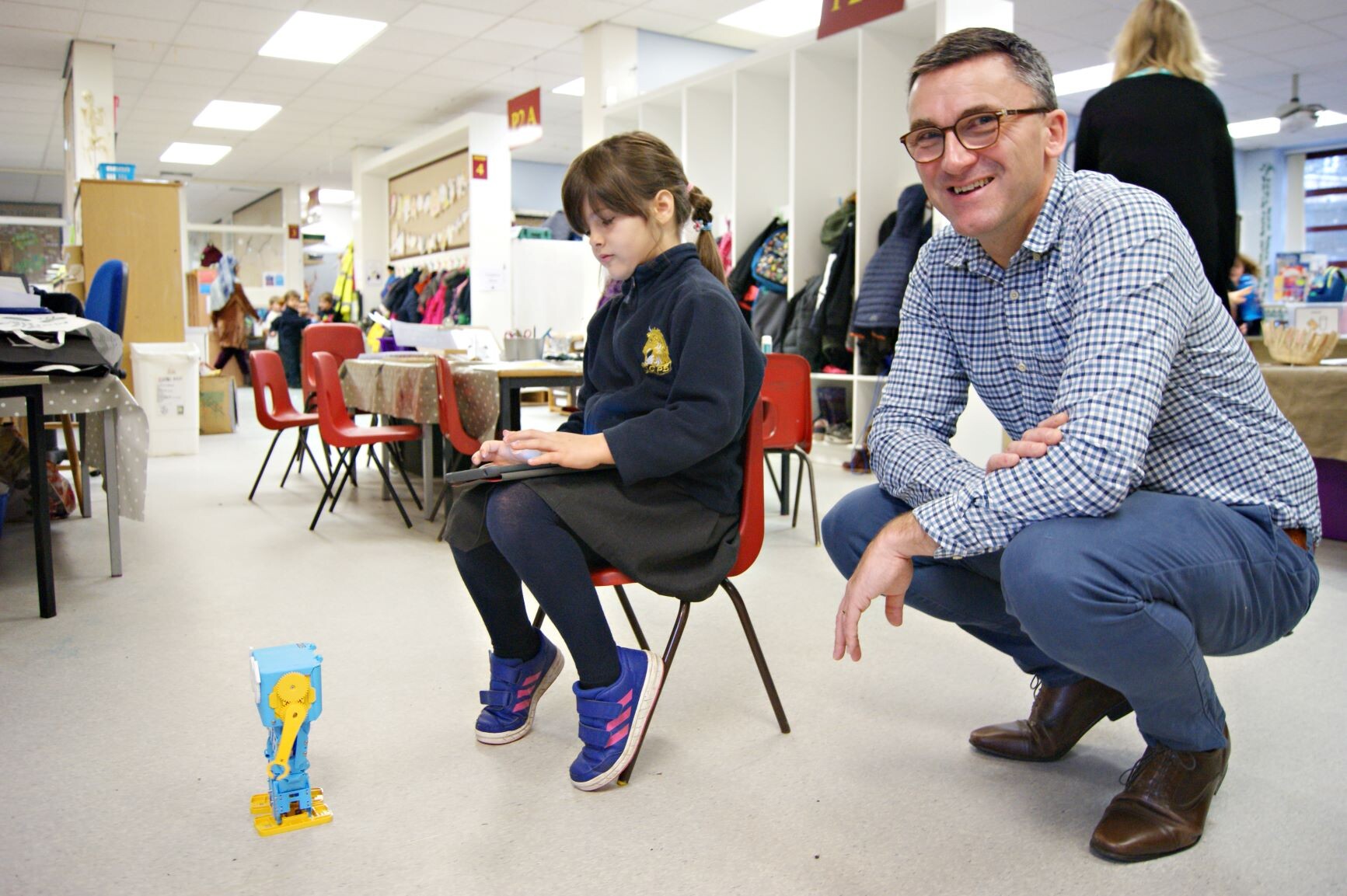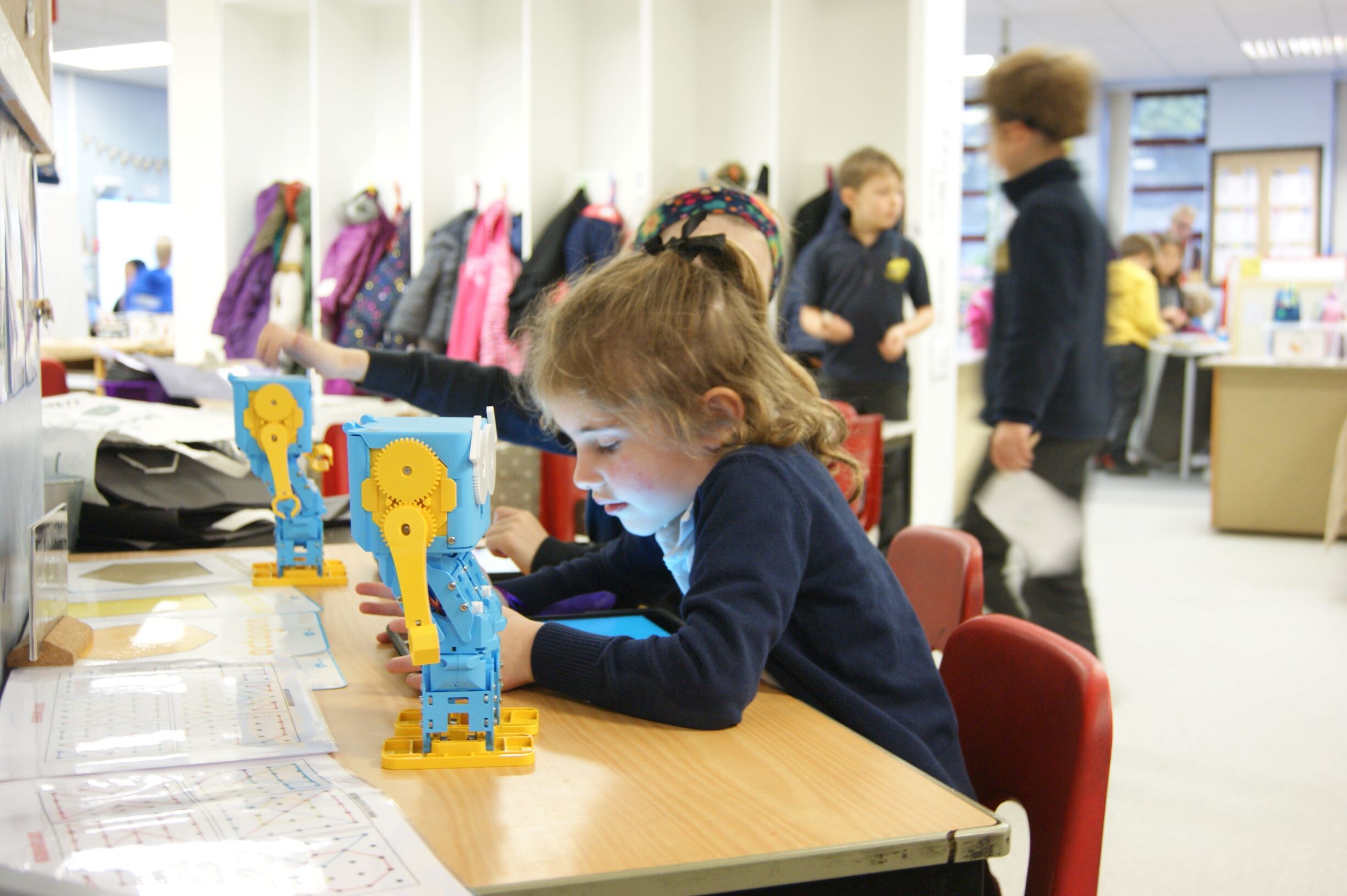Child's play: how robots are becoming a part of the classroom
Children are using devices of increasing complexity from a young age. What does it do to improve their learning?
“Now remember, Primary Two’s” Miss Davies says, holding her hands up for the class to see.
“We’ve got our left,” she says, wiggling her forefinger and thumb. “That looks like an L. And then - what’s this one ? - yes, that’s my right. Well done.”
It sounds like the beginning of a typical classroom exercise. But the pupils in James Gillespie’s Primary School in the west of Edinburgh are about to try something new.
Lined up in the adjacent room are six small, blue and yellow robots, each with a corresponding iPad.
“Some of us have seen Marty before,” the teacher says, referring to the humanoid bots by their proper noun.
“We’ve been doing some coding on the iPad. And we’ve been going outside and we’ve been learning a lot about going left, and going right, and going forward, and we’ve been thinking about our directions so that we can think about how to control Marty,” she reminds the class.
Stood alongside Miss Davies is Tanya Howden, who works for the manufacturers of the Marty robot, the nearby Marchmont-based Robotical.
Technology like this is fast becoming a common sight in schools across Scotland, as our education system changes to accommodate the integration of computing and automation into our daily lives.
From tablets to drones, children are being exposed to devices of increasing complexity from a young age.

These P2s are guinea pigs of a sort, though. Normally, Howden runs sessions with children from 10-years-old and up. How these excitable seven-year olds would take to Marty was unclear.
“Can Marty talk a little bit?” one boy asks Howden. She explains that Marty can walk, dance, kick, wave - but right now he can’t talk, beyond a few beeps.
“When you’re older, maybe you can make a Marty that speaks,” Miss Davies suggests.
A burst of giggly chatter breaks out. “I want to be an engineer when I’m bigger,” another child proclaims.
It might seem exceedingly futuristic given how quickly things have leapt from Lego and Meccano to programmable robots, but the reasons for introducing devices like Marty to the classroom - or any of the other now commonplace robots like Beebots and Spheros - are actually quite straightforward.
A term that educators and policy makers nowadays are all familiar with is ‘computational thinking’.
Teachers are being encouraged to see the use of coding languages and programmable hardware as an opportunity to develop a mode of thinking based on logic and creative problem solving.
It’s hoped that instilling this thought process early on will prepare children for the type of work - and broadly the type of society - they’ll inhabit when they’re older.
Typically at this age kids will concentrate for about 15 minutes - but you can see with the robot, they could probably go all morning because it’s such an engaging thing to do."
- Colin McLean, head teacher
In one corner of the classroom, two girls are trying to get their robots to walk across a desk, meet in the middle and shake hands. Crouching next to them is Colin McLean, the headteacher.
“So, how many steps do you think they are apart?” McLean asks them.
“Um, 22?” one replies.
“Go on then, try 22 steps,” McLean says, rising from his crouch to regard the blur of activity among the pupils.
“We’re trying to get them to make guesstimates, and test them out, then revisit them,” McLean says.
“It’s kind of the beginnings of what we might call glitching and looping and coding.”
Having robots carry out instructions makes the theory vivid for children. Often, though, exercises are done entirely without devices.
“Some of the stuff we do is off technology. It’s using our bodies or paper.
“The ‘computational thinking’ thing doesn’t have to be about technology.
“You know, typically at this age kids will concentrate for about 15 minutes - but you can see with the robot, they could probably go all morning because it’s such an engaging thing to do.”

McLean has developed a particular enthusiasm for bringing digital skills to classrooms.
In 2017 there had been a “refresh” of aspects in the technologies section of the Curriculum for Excellence. This has been the only major update to the curriculum, which Education Scotland said was needed because the section was dated.
McLean applied to attend the European School Heads’ Association conference, which in 2018 was centred on technology in education and hosted in Tallinn, Estonia. The trip was part-funded by the Scottish Government and the school leaders’ trade union AHDS.
Estonia is seen as a model of success in creating an information and innovation based economy, largely down to strategic decisions taken in education over the decades since it gained independence from the collapsing Soviet Union.
McLean says what he saw drew a sharp contrast with where Scotland seemed to be.
“That’s when the penny dropped, that we really are quite far behind some other countries in what we’re doing in STEM,” he said.
The Scottish Government has made available a grant called the Career Long Professional Learning in STEM, which aims to help schools modernise.
“So that inspired me to come back, draw from the government fund and develop a partnership with a local tech company (Robotical).”
“They’re helping our children and our staff to skill up and give us confidence to teach this stuff because it’s quite new.”
Ian Stuart is the former principal technology teacher in Islay High School, which was one of the most technologically advanced high schools in the UK and where his pupils began using tablets in 2005.
“The definition I always use with pupils is: technology is something that helps you do something better. It’s a tool,” Stuart says.
“Really, a pencil is a piece of technology because it’s made by humans and it helps you do something better. Robotics is the other end of that extreme.”
In 2013 Stuart was seconded to the Scottish Government’s Digital Directorate to help reboot the floundering Glow online support system. He then worked on the development of the government’s Digital Learning and Teaching Strategy, which lead to the “refresh” in 2017.
The open-ended nature of the curriculum doesn’t specify exactly how, when and in which subjects tech should be used in the classroom.
“When you think back to school you don’t remember the experience of having to sit a test or write an essay, but you do remember school shows, discos, school visits, going out. Those are the experiences that enhance the outcomes.”
“Experiential learning builds on the theory learning,” he said.
“The two are required. It’s not one or the other, it’s both.”

Tanya Howden of Robotical says teaching teachers is as important as pupils.
As the learning experience designer for the company, Howden’s job involves developing robotics teaching resources, and she often goes in to schools to run sessions and provide training for staff.
“I think they just need a little bit of support that first time that they take it to a classroom,” she says.
“Because, I know this from teaching code clubs - there’s nothing more terrifying than standing in front of a group of kids and you don’t know what you’re talking about.”
“Once you get over that first lesson, they tend to realise they can just leave it to the kids a little bit, because kids are basically born with tablets nowadays.”
Holyrood Newsletters
Holyrood provides comprehensive coverage of Scottish politics, offering award-winning reporting and analysis: Subscribe